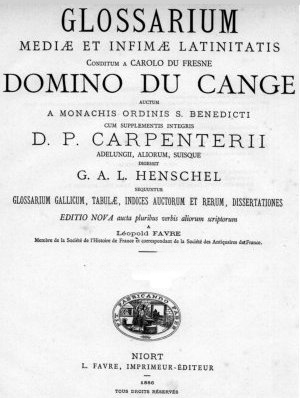[First posted in AWOL 15 February 2010, updated 11 August 2019]
Du Cange, et al., Glossarium mediæ et infimæ latinitatis. Niort : L. Favre, 1883-1887.
![Bookmark and Share]()
Du Cange, et al., Glossarium mediæ et infimæ latinitatis. Niort : L. Favre, 1883-1887.
Le Glossarium mediae et infimae latinitatis, initialement publié par Charles du Fresne, sieur (1610-1688), est un glossaire du latin médiéval, en latin moderne.
Quoi ? — Un glossaire n'est pas un dictionnaire.
Averti de ce que le Glossarium n’est pas, le lecteur y vient généralement après avoir consulté des lexiques plus récents, notamment le Mediae latinitatis lexicon minus de (Leiden : Brill, 1976-…). Dans un texte médiéval, en latin (mais aussi en vernaculaire européen), beaucoup de notions résistent à la traduction, et même à la compréhension. Le du Cange peut apporter des éclairages utiles.
- un glossaire n’est pas un dictionnaire monolingue, par exemple, il ne comporte pas d’information grammaticale ;
- un glossaire n’est pas un dictionnaire bilingue, les mots n’ont pas de traductions, les explications sont en latin ;
- une glose n’est pas une définition, mais une explication courte, ou un commentaire, et parfois toute une dissertation ;
- le latin médiéval n’est pas du latin classique (ni moderne), mais la langue écrite d’un continent pendant un millénaire ;
- la graphie du latin médiéval a beaucoup varié selon les lieux et les siècles, un même mot peut se trouver à plusieurs endroits de l’alphabet ;
- le Glossarium est pour moitié composé de citations, dont beaucoup sont en ancien français.
Qui ? — Auteurs et histoire éditoriale.
Le texte informatisé résulte d’une histoire éditoriale de deux siècles, voir par exemple Hercule Géraud, « Historique du Glossaire de la basse latinité de Du Cange» (Bibliothèque de l'école des chartes, 1840).Chaque éditeur a conservé la mémoire des ajouts par différents signes et puces. La légende en est donnée au début de chaque volume papier. Des traitements informatiques ont pu conserver cette information dans le texte numérisé, et l'afficher de manière plus lisible pour le public.
- (1678), le sieur publie son Glossarium en 3 tomes.
- (1733-1736), les de la congrégation de Saint-Maur augmentent le contenu, en s’insérant dans le plan initial.
- (1766), Pierre ajoute un supplément de 4 volumes d'articles.
- (1840-1850), Louis fond la nomenclature de Carpentier et des Bénédictins pour les éditions Didot, ajoute des articles, et réunit deux tomes d’annexes.
- (1883-1887), Léopold compose la dernière édition, réimprimée jusqu’au XXe siècle, 10 tomes.
L’ensemble consultable résulte de l’édition Favre, qui s’étend sur 10 tomes, 6000 pages, dont 5000 de dictionnaire latin, 90 000 articles, 6 millions de mots. Les ajouts ont à peu près doublé la taille du texte de , généralement par de courts articles, des sous-vedettes, de nouvelles citations, et des précisions dans les références. L’histoire éditoriale a peu modifié les intentions de du Cange, si bien que l’ouvrage reste largement influencé par son auteur initial, et la lexicographie du XVIIe siècle. Ce glossaire n'est pas un dictionnaire très systématique, tant dans l'inventaire des emplois, que l'économie de la nomenclature.Comment ? — Informatisation XML/TEI.
Cette édition électronique a été encodée en XML, selon un schéma documenté, conforme au modèle TEI P5. Une équipe pluridisciplinaire de latinistes, de lexicographes, d'historiens et d'informaticiens, garantit le soin porté au texte. L'application continuera de s'améliorer selon vos réactions et suggestions.



 · [
· [






























